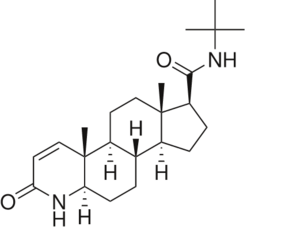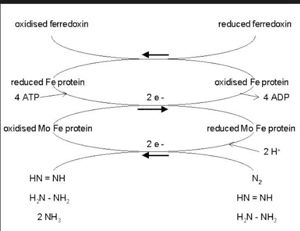Finasteride
From Proteopedia
(Difference between revisions)
| Line 34: | Line 34: | ||
==='''Androgenetic Alopecia (AGA)'''=== | ==='''Androgenetic Alopecia (AGA)'''=== | ||
| - | Androgenetic alopecia (AGA) is an androgen-dependent, progressively thinning of the scalp hair. AGA is also referred to as male-pattern hair loss or baldness (MPB) and female-pattern hair loss in women. It is characterized by progressive shortening of the duration of anagen with successive hair cycles, leading to decreased numbers of hair in anagen at any given time, and aggressive follicular miniaturization with conversion of terminal to vellus-like follicles <ref name="thirty"> Paus, R., Cotsarelis, G. (1999).The biology of hair follicles. N. Engl. J. Med., 34, 491–497. </ref> The reason for the use of finasteride to treat AGA in men is based on the absence of AGA in men with congenital deficiency of type 2 5α-reductase, and the presence of increased 5α-reductase activity and DHT levels in balding scalp <ref name=" | + | Androgenetic alopecia (AGA) is an androgen-dependent, progressively thinning of the scalp hair. AGA is also referred to as male-pattern hair loss or baldness (MPB) and female-pattern hair loss in women. It is characterized by progressive shortening of the duration of anagen with successive hair cycles, leading to decreased numbers of hair in anagen at any given time, and aggressive follicular miniaturization with conversion of terminal to vellus-like follicles <ref name="thirty"> Paus, R., Cotsarelis, G. (1999).The biology of hair follicles. N. Engl. J. Med., 34, 491–497. </ref> The reason for the use of finasteride to treat AGA in men is based on the absence of AGA in men with congenital deficiency of type 2 5α-reductase, and the presence of increased 5α-reductase activity and DHT levels in balding scalp <ref name="two"> Yamana, K., Labrie, F., Luu-The, V. (2010). Human type 3 5α-reductase is expressed in peripheral tissues at higher levels than types 1 and 2 and its activity is potently inhibited by finasteride and dutasteride. Hormone Molecular Biology and Clinical Investigation. 2 (3). doi:10.1515/hmbci.2010.035. </ref>. This condition is caused by a build up of DHT in tissues, which in the case of MPB, is the scalp. The build up of DHT causes androgen-dependent miniaturization of scalp hair follicles. Testosterone is the primary androgen in the body, but to be maximally active in scalp hair follicles it must be converted to dihydrotestosterone (DHT) by the enzyme 5α-reductase. Inhibition of the enzyme with Finasteride has been shown to reduce both serum and scalp skin DHT levels in balding men. In some patients, hair regrowth can occur.<ref name="twelve"> Olsen, E. A., Hordinsky, M., & Whiting, D., et al. (2006, December). </ref> Side effects from Finasteride include but are not limited to, decreased sexual ability and desire. <ref name="thirteen"> Leyden, James et al.(June 1999)."Finasteride in the treatment of men with frontal male pattern hair loss." Journal of the American Academy of Dermatology. Volume 40 , Issue 6 , 930 - 937 </ref> |
Revision as of 14:48, 6 December 2016
N-(1,1-dimethylethyl)-3-oxo-(5α,17β)-4-azaandrost-1-ene-17-carboxamide (Finasteride)
| |||||||||||
References
- ↑ 1.0 1.1 I.K. Morton; Judith M. Hall (6 December 2012). Concise Dictionary of Pharmacological Agents: Properties and Synonyms. Springer Science & Business Media. pp. 121, 246. ISBN 978-94-011-4439-1
- ↑ 2.0 2.1 2.2 Yamana K, Labrie F, Luu-The V (January 2010). Human type 3 5α-reductase is expressed in peripheral tissues at higher levels than types 1 and 2 and its activity is potently inhibited by finasteride and dutasteride. Hormone Molecular Biology and Clinical Investigation. 2 (3). doi:10.1515/hmbci.2010.035
- ↑ Varothai, S; Bergfeld, WF (Jul 2014). "Androgenetic alopecia: an evidence-based treatment update.". American journal of clinical dermatology. 15 (3): 217–30. doi:10.1007/s40257-014-0077-5. PMID 24848508
- ↑ 4.0 4.1 4.2 Lednicer D (2011). Steroid Chemistry at a Glance. Hoboken: Wiley. ISBN 978-0-470-66084-3
- ↑ Burkhard Fugmann; Susanne Lang-Fugmann; Wolfgang Steglich (28 May 2014). RÖMPP Encyclopedia Natural Products, 1st Edition, 2000. Thieme. pp. 1918–. ISBN 978-3-13-179551-9
- ↑ Schieck, Cynthia L.(1998, August) "Finasteride (Propecia ®)". http://www.chm.bris.ac.uk/motm/finasteride/Finasteride%20(Propecia)%20-%20Feature%20Molecule.htm
- ↑ 7.0 7.1 Bull, Herbert G.*Garcia-Calvo,Margarita Andersson,Stefan†, Baginsky, Walter F.,Chan,H. Karen,Ellsworth,‡ Dina E., Miller,§ Randall R., Stearns,Ralph A.,Bakshi,Raman K.,Rasmusson, Gary H.,Tolman,Richard L., Myers,Robert W.,Kozarich,John W.,Harris,Georgianna S. (1995, August 6) Mechanism-Based Inhibition of Human Steroid 5R-Reductase by Finasteride: Enzyme-Catalyzed Formation of NADP-Dihydrofinasteride, a Potent Bisubstrate Analog Inhibitor. http://pubs.acs.org/doi/pdf/10.1021/ja953069t
- ↑ Tacklind, J., Fink, H.A., MacDonald, R., Rutks, I., Wilt, T.J. (2010). Finasteride for benign prostatic hyperplasia. Cochrane database of systematic reviews 2010, Issue 10. Art. No.: CD006015. DOI: 10.1002/14651858.CD006015.pub3.
- ↑ Dragan, I., Misso, M. (2012). Lycopene for the prevention and treatment of benign prostatic hyperplasia and prostate cancer: A systematic review. Maturitas, 72 (4), 269
- ↑ 10.0 10.1 Robaire, B., Henderson, N.A. (2006). Actions of 5alpha-reductase inhibitors on the epididymis. Molecular and Cellular Endocrinology. 250 (1-2): 190–5. doi:10.1016/j.mce.2005.12.044
- ↑ Paus, R., Cotsarelis, G. (1999).The biology of hair follicles. N. Engl. J. Med., 34, 491–497.
- ↑ Olsen, E. A., Hordinsky, M., & Whiting, D., et al. (2006, December).
- ↑ Leyden, James et al.(June 1999)."Finasteride in the treatment of men with frontal male pattern hair loss." Journal of the American Academy of Dermatology. Volume 40 , Issue 6 , 930 - 937
Proteopedia Page Contributors and Editors (what is this?)
Joel L. Sussman, Cody J Cubbage, Michal Harel, Alexander Berchansky




